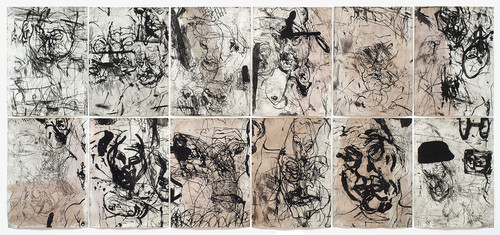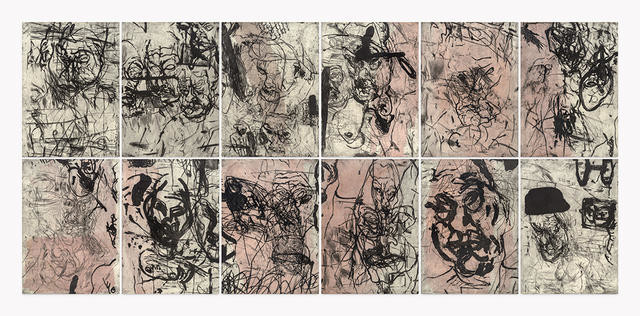B.
12 Untitled self portraits (Set 6) (Polish mud) by Mike Parr
Collection
This article first appeared in The Press on 12 October 2005

Mike Parr 12 Untitled self portraits 1995. Dry-point, lift-ground aquatint and shellac wash. Collection of Christchurch Art Gallery Te Puna o Waiwhetū, purchased 2002. Reproduced courtesy of Mike Parr and Viridian Press
You could argue that Mike Parr - widely regarded as one of Australia's most important contemporary artists - has suffered more for his art than many. Since 1971, his shocking and often violent performances have tested his physical and psychological limits - and provided harrowing viewing for audiences. In 1972, Parr convinced a friend to bite into his shoulder for as long as possible. The following year, he branded himself - literally - with the word 'artist'. He has mutilated his body, starved himself, held his breath to the point of collapse and, in a well-documented 2002 performance, he sewed up his lips and face to express solidarity with the refugees and asylum seekers in Australia's now-infamous detainee camps. All of these actions were captured on film, and one of Parr's most recent works, in which he nailed his arm to a gallery wall for 30 hours, went out as a live web-cast, available to viewers at the click of a button.
If Parr makes demands of his audience, he is even harder on himself. He approaches his work with a devastating intensity, exhibiting prodigiously and creating works across a wide range of media. In addition to his performances, he has produced installations, sculptures, text-based works, drawings and etchings. One of his most remarkable achievements, the ‘Self Portrait' project, involves over a thousand works across a range of media. A set of twelve untitled drypoint etchings from that series is currently on display at the Christchurch Art Gallery Te Puna o Waiwhetū.
Characteristically raw and confrontational, these etchings (made in 1995) are part of an ongoing collaboration begun in 1987 between Parr and John Loane, the master printmaker of Melbourne's Viridian Press. From the beginning, Parr enjoyed the distance the printmaking process offered from the self-conscious act of drawing - a freedom from the discomfort that he had previously expressed by scrubbing out and drawing over his images. At first, he worked from gridded photographs, but from 1988 onwards he has gleaned his images from the mirror or his memory. The inconsistencies and distortions that result from this approach are valued by Parr, who views the idea of ‘likeness' as an essentially fictive construct. In drypoint etching, lines are scratched into the surface of a bare metal plate with a sharp point or other abrasive tool - an expressive, physical technique that seems to suit the agression of Parr's natural artistic approach. Like a series of shifting and dissolving masks, his blurry, ‘beheaded' faces frustrate our attempts to extract a clear sense of identity, while the accidental imperfections of the printing process- the ‘foul bites' and visual static - further separate his work from conventional self-portraiture.
In his recent work, 100 Breaths, Parr drew a direct link between his printmaking and performance practices. Sheet by sheet, he held 100 of his self-portraits against his face by sucking air through the paper. Against a soundscape of desperate, gasping breaths, he momentarily ‘wore' each of these representations, mimicking the ultimately futile artistic attempt to contain a true impression of self within two, or even three, dimensions.
Felicity Milburn
